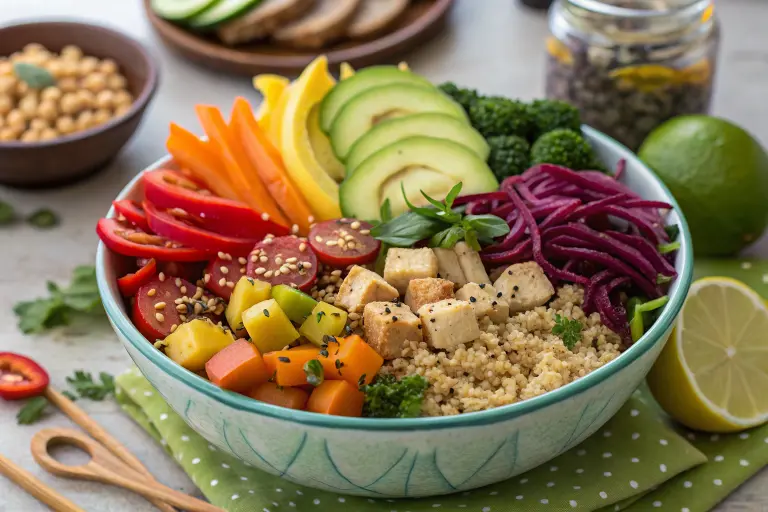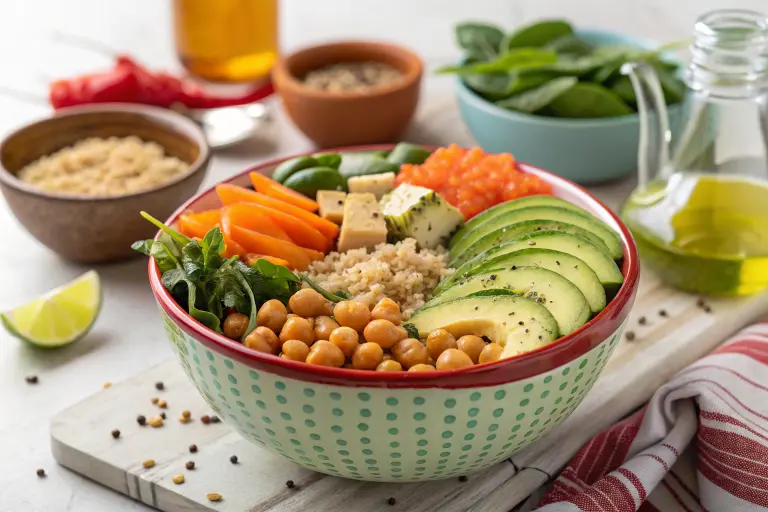In recent years, Buddha bowls have captured the attention of health enthusiasts, foodies, and home cooks alike. But what makes it a Buddha bowl so special, and why has it become such a trendy yet timeless meal choice? A Buddha bowl is not just another salad or grain bowl; it’s a well-balanced, nutrient-packed dish that brings together an assortment of wholesome ingredients in one colorful and satisfying meal.
Whether you’re looking to boost your health, add more plant-based meals to your diet, or simply indulge in something delicious, the Buddha bowl checks all the boxes. But what makes it a Buddha bowl truly stand out from other meals? It’s the perfect combination of grains, proteins, vegetables, and healthy fats, all customized to your unique taste preferences. Plus, it’s versatile enough to suit any diet, from vegan to omnivore.
In this article, we’ll discover the key components that define a Buddha bowl, the numerous health benefits it offers, and how you can easily create your own vibrant bowl of goodness. So, if you’ve ever wondered what makes it a Buddha bowl more than just a trendy dish, keep reading to discover how this nourishing meal can transform your eating habits.
What is a Buddha Bowl?
A Buddha bowl is a wholesome, one-bowl meal that typically includes a combination of vegetables, grains, proteins, and dressings. The idea is to create a balanced, nutrient-dense dish that is both satisfying and colorful. Buddha bowls are customizable, allowing you to mix and match ingredients according to your preferences or dietary restrictions. But what makes it a Buddha bowl distinct from a regular salad or grain bowl?
Key Components of a Buddha Bowl
- Base: The base usually consists of grains such as quinoa, rice, or couscous.
- Vegetables: Fresh, raw, or roasted vegetables make up the majority of the bowl. Common choices include leafy greens, sweet potatoes, and avocado.
- Protein: You can add protein-rich foods like chickpeas, tofu, tempeh, or grilled chicken.
- Healthy Fats: Ingredients like avocado, nuts, and seeds provide healthy fats to keep you full.
- Dressing: A flavorful dressing pulls everything together. Tahini, olive oil, and lemon juice are common options.
The real charm of Buddha bowls lies in their versatility and simplicity. Now, let’s explore what makes it a Buddha bowl even more intriguing and delicious.
What Makes It a Buddha Bowl? The Balance of Nutrients
The true essence of a Buddha bowl lies in the balance of nutrients it offers. When you carefully select the ingredients that go into your bowl, you are ensuring that your meal contains a mix of carbohydrates, proteins, healthy fats, and fiber.
Why Nutrient Balance Matters
- Carbohydrates: Grains like quinoa and rice provide long-lasting energy.
- Proteins: Beans, lentils, and tofu offer plant-based proteins for muscle repair and growth.
- Healthy Fats: Nuts, seeds, and avocado help with nutrient absorption and hormone regulation.
- Fiber: Vegetables and whole grains are high in fiber, supporting digestion and overall gut health.
When what makes it a Buddha bowl comes together, it’s not just about taste—it’s about creating a well-rounded, nourishing meal that fuels the body and keeps you energized throughout the day.
What Makes It a Buddha Bowl? The Importance of Color and Presentation
One of the first things you’ll notice about a Buddha bowl is its vibrant, colorful presentation. Each ingredient in a Buddha bowl is carefully chosen to not only benefit your body but also delight your eyes. From the deep green of leafy kale to the golden hue of roasted sweet potatoes, the colors in a Buddha bowl signify the wide array of vitamins and minerals present.
The Psychological Impact of Colorful Food
Studies show that colorful meals are often associated with better health. The vibrant array of vegetables and grains provides a spectrum of micronutrients and antioxidants, which contribute to overall well-being. Additionally, a visually appealing meal can make the eating experience more enjoyable, leading to greater satisfaction.
Common ingredients in a Buddha bowl that contribute to its vibrant color include:
- Green: Kale, spinach, broccoli, peas, and avocado.
- Orange/Yellow: Sweet potatoes, carrots, and corn.
- Red: Beets, bell peppers, and tomatoes.
- Purple: Purple cabbage, eggplant, and purple sweet potatoes.
The more colorful your Buddha bowl, the more nutrient diversity it offers. What makes it a Buddha bowl so attractive isn’t just the flavor, it’s the visual balance that enhances your dining experience.

What Makes It a Buddha Bowl? Customizing to Your Taste
One of the standout features of Buddha bowls is their customization. You can make them as simple or as elaborate as you like. This flexibility makes Buddha bowls appealing to a wide range of eaters, whether you’re vegan, vegetarian, or an omnivore.
Vegan and Vegetarian Buddha Bowls
If you’re following a plant-based diet, a Buddha bowl is the perfect way to include a variety of nutrient-dense foods without compromising on flavor. You can fill your bowl with a combination of quinoa, roasted vegetables, tofu, and a tahini dressing for a wholesome vegan meal.
Omnivore Buddha Bowls
For those who enjoy a more varied diet, adding animal proteins such as chicken, turkey, or fish is a great way to increase the protein content of your Buddha bowl. It’s easy to incorporate these proteins into your bowl without sacrificing the dish’s healthful appeal.
Popular Protein Options:
- Grilled chicken breast
- Roasted salmon
- Tempeh or tofu (vegan)
- Black beans, chickpeas, or lentils
Whatever your preference, what makes it a Buddha bowl adaptable is its flexibility in catering to all dietary needs. You are in control of what goes in your bowl!
What Makes It a Buddha Bowl? The Health Benefits
A Buddha bowl isn’t just a trendy meal; it also comes with numerous health benefits. Thanks to its balanced, whole-food ingredients, a Buddha bowl can support various aspects of your health, from digestion to heart health. Let’s take a closer look at the specific health benefits of a Buddha bowl.
1. Supports Digestive Health
The high fiber content from vegetables, grains, and legumes helps keep your digestive system running smoothly. Fiber promotes regular bowel movements, reduces bloating, and supports gut health.
2. Provides Steady Energy
With a balance of healthy carbohydrates, proteins, and fats, a Buddha bowl offers sustained energy throughout the day. Unlike highly processed meals that cause blood sugar spikes, a well-balanced Buddha bowl provides a slow and steady release of energy.
3. Boosts Immune Function
The antioxidant-rich ingredients found in a Buddha bowl, such as leafy greens and colorful vegetables, support your immune system. Vitamin C-rich foods like bell peppers, tomatoes, and citrus also contribute to overall health by fighting off infections.
4. Aids in Weight Management
Thanks to its nutrient density and high fiber content, Buddha bowls can help with weight management. Fiber keeps you feeling full longer, reducing the likelihood of overeating. Additionally, the combination of protein and healthy fats in a Buddha bowl helps regulate hunger hormones.
By consuming a Buddha bowl, you’re not only eating for flavor but also for your health. What makes it a Buddha bowl is its ability to nourish the body from the inside out.
How to Make Your Own Buddha Bowl
Now that you know what makes it a Buddha bowl and the health benefits it offers, you might be eager to make your own. Here’s a simple guide to creating a delicious and satisfying Buddha bowl at home.
Step 1: Choose Your Base
Start by selecting a whole grain such as quinoa, brown rice, or farro. These grains provide the necessary carbohydrates for energy.
Step 2: Add Vegetables
Add a variety of vegetables for both color and nutrients. You can use both raw and cooked vegetables, such as kale, spinach, roasted sweet potatoes, or steamed broccoli.
Step 3: Include a Protein Source
Pick a protein source that aligns with your dietary needs. For a plant-based bowl, you could add tofu, chickpeas, or edamame. For a meat-based bowl, try grilled chicken, turkey, or salmon.
Step 4: Add Healthy Fats
Top your bowl with healthy fats like avocado, nuts, or seeds. These fats will help keep you satisfied and support your body’s absorption of fat-soluble vitamins.
Step 5: Dress It Up
Finally, drizzle your Buddha bowl with a delicious dressing. Tahini, olive oil, lemon, and balsamic vinegar are all great options. The dressing adds flavor and ties all the ingredients together.
Sample Buddha Bowl Recipe:
- Base: Quinoa
- Vegetables: Roasted sweet potatoes, kale, avocado, and cherry tomatoes
- Protein: Grilled chicken breast
- Healthy Fats: Chia seeds and sliced almonds
- Dressing: Tahini-lemon dressing

FAQs: What Makes It a Buddha Bowl?
❓ What makes it a Buddha bowl different from other bowls?
A Buddha bowl stands out by its perfect balance of grains, vegetables, proteins, and healthy fats, all in one nourishing, colorful dish. What makes it a Buddha bowl is the focus on providing a well-rounded, nutrient-dense meal that’s customizable to any diet.
❓ Can I make a Buddha bowl without grains?
Yes! While grains like quinoa or rice are common, you can omit them and still enjoy a satisfying Buddha bowl. Just focus on including other nutrient-rich ingredients like vegetables, proteins, and healthy fats.
❓ What makes it a Buddha bowl so nutritious?
What makes it a Buddha bowl nutritious is its balanced combination of high-fiber vegetables, plant-based proteins, whole grains, and healthy fats, all of which contribute to overall health and sustained energy levels.
❓ Is a Buddha bowl suitable for vegan diets?
Absolutely! A Buddha bowl can easily be made vegan by using plant-based proteins like tofu, tempeh, or chickpeas and adding healthy fats such as avocado or nuts.
❓ How do I know if I’m making the perfect Buddha bowl?
To create the perfect Buddha bowl, focus on balance: include a variety of colorful vegetables, a whole grain base, a protein source, and a healthy fat. What makes it a Buddha bowl perfect is the harmony between these elements, all tied together with a flavorful dressing.
Conclusion: what makes it a Buddha bowl?
In conclusion, what makes it a Buddha bowl? is its thoughtful combination of fresh, nutrient-rich ingredients designed to fuel your body and delight your taste buds. Whether you’re looking for a quick meal, a post-workout recovery dish, or a way to incorporate more plant-based foods into your diet, Buddha bowls are the ideal choice. They offer versatility, balance, and the ability to customize based on your dietary needs and preferences. With their combination of grains, vegetables, proteins, and healthy fats, Buddha bowls provide everything your body craves to stay energized and nourished.
As we’ve seen, what makes it a Buddha bowl truly special is its power to bring together a variety of ingredients that nourish your body while keeping your meals exciting and visually appealing. Next time you’re looking for a wholesome, vibrant meal, don’t forget to craft your own Buddha bowl. Remember, the key is balance, fill your bowl with various colors, textures, and flavors for a satisfying and complete meal.
If you’re craving more delicious bowl ideas, why not try a fresh salmon poke bowl? It’s another flavorful option that offers a great balance of healthy ingredients, and it’s super easy to prepare. Check out our full Salmon Poke Bowl recipe for more details. If you’re interested in other poke variations, don’t miss our Poke Bowl Recipe to keep your meals exciting and diverse.
For more delicious, healthy recipes and inspiration, visit our Chaynez Recipes platforms, where we share everything from easy weeknight dinners to creative bowls that will nourish and satisfy.






